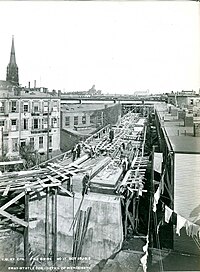마티아스 라우흐밀러
Matthias Rauchmiller마티아스 라우흐밀러(Matthias Rauchmiller, 일명 마티아스 라우흐뮐러)는 1675년 이후 비엔나에서 활동하며 영향력 있는 화가, 조각가, 상아 카버였다.1645년 1월 11일 라돌펠(독일 콘스탄스 호수 근처)에서 태어나 1686년 2월 5일 빈에서 사망하였다.[1]
삶과 일
라흐밀러는 1645년 라돌펠러에서 정육점 주인 마티아스 라우흐뮐러와 그의 아내 아가타 슈미드의 막내아들로 태어났다."[2]: 9–10
그는 아마도 근처의 콘스탄츠에 있는 조각가 집안에서 그의 초기 예술 훈련을 받았을 것이다.[3]젊었을 때, 그는 또한 남네덜란드를 여행했는데,[4] 그 곳에서 그는 로마의 위대한 바로크 조각가 지안 로렌초 베르니니와 관련된 작품을 포함한 피터 폴 루벤스와 그의 원의 영향을 받았다.[2]: 17–18
라우흐밀러는 1669년에서 1671년 사이에 마인츠에서 일했는데, 그곳에서 그는 지역 성당을 위해 십자가를 만들었다.1675년경 그는 1679년 마인츠 대주교 당선자, 웜스 주교로 선출된 카를 하인리히 폰 메테르니히-위너버그의 대리석 무덤을 만들도록 위임받았으나 주교로 봉헌되기도 전에 죽었다.이 무덤은 독일 트리에 있는 리브프라우엔키르슈에 세워졌다.미술사학자인 로라 월류(Laura Walew)의 이 무덤에 대한 에세이에 따르면 30년 전쟁 후 알프스 북쪽에 누운 모습을 가진 최초의 무덤 중 하나라고 한다.[2]: 11–12 앞서 무덤에서 죽은 사람이 무릎을 꿇고 있는 모습을 주로 볼 수 있었다.
로크밀러의 리브프라우엔키르체 무덤 조각은 책을 읽으며 뒤로 젖혀지는 메테르니치의 모습을 보여주고 있으며, 통통한 근육질의 퍼토(루벤스 재조명)는 감탄하며 바라본다.왈웨에 따르면 "메테르니히 무덤은 강한 성품을 지닌 지성인에게 섬세하고 표현적인 경의를 표하는 인상을 준다"[5][2]: 23 고 한다.
어떤 이들은 '사빈 여인들의 강간' 장면이 담긴 그의 1676년 상아 탱커드를 '마스터워크'로 여겼다.[3]이 탱커드는 현재 리히텐슈타인의 프린스리 컬렉션에 있다.[1]
1679년, 라흐밀러는 부보닉 페스트의 전염병 종식을 기념하는 비엔나 기념비를 설계하도록 의뢰되었다; 당시 전형적인 기둥 모양의 "플래그 기둥" 대신에, 라흐밀러는 정교한 조각 장식이 있는 3면 피라미드를 구상했다.[3]이 기념비는 나중에(1694년) 다른 화가들에 의해 완성되었지만, 라우크밀러의 일반적인 디자인은 그대로 남아 있다.그의 조각품들 중 3점(실제 크기의 천사들)은 비엔나 그라벤의 현대 페스트 칼럼에서도 여전히 볼 수 있다.[3]
1681년에 Rauchmiller는 St.를 위해 점토 모형을 디자인했다. 1683년 프라하의 샤를 다리 위에 설치된 존 네포묵 동상.[6]네포묵상은 현재 다리 위에 있는 많은 바로크 성도들 중 첫 번째 조각상이었다.라우흐밀러의 점토 모형(아직도 프라하 국립 미술관에 전시되어 있음)은 조각가 얀 브로코프에 의해 나무로 처형된 다음 뉘른베르크의 종 제작자인 히에로니무스 헤럴드에 의해 청동으로 주조되었다.[6]로크밀러의 보제토의 우상화는 19세기에 성인의 우상화를 불러일으켰다.[6]
참조
- ^ a b "Matthias Rauchmiller". Liechtenstein Museum. Retrieved July 10, 2018.
The painter, sculptor and ivory carver Matthias Rauchmiller (also known as Rauchmüller) was born on 11 January 1645 in Radolfzell and died in Vienna on 5 February 1686. In 1675 he settled in Vienna. As a leading artist of his time, Rauchmiller made the transition from early to high Baroque. The chief works of Rauchmiller include impressive tombs (marble grave of Bishop Karl von Metternich in the Liebfrauenkirche, Trier, built around 1675). He also contributed to the construction of the Vienna Plague Column. The murals in the Dominican church in Vienna (1675) and the terracotta model of Saint John Nepomuk on the Charles Bridge in Prague (1681) are also by him. His most noted work is an ivory carving depicting a tankard with bacchic scenes (1676). (English translation of German original)
- ^ a b c d Walew, Laura (2010). "Matthias Rauchmillers Grabmal des Bischofs Karl von Metternich in der Liebfrauenkirche zu Trier (1670/74)". Matthias Rauchmiller's Tomb of Bishop Karl von Metternich in the Liebfrauenkirche in Trier (1670/74). Retrieved July 13, 2018.
Matthias Rauchmiller was born on 11 January 1645 in Radolfzell on Lake Constance as the youngest child of the inhabitant and butcher, of the "honestus Mathias Rauchmüller" and his wife, the "virtuosa Agatha Rauchmüllerin."
- ^ a b c d Kossatz, Tillman. "Rauchmiller, Mathias". New German Biography 21 (2003). pp. 200–201. Retrieved July 10, 2018.
In 1679 R. was awarded the contract for the Trinity Column donated by King Leopold I to the Graben in Vienna (completed in 1694) according to plans by JB Fischer von Erlach and L. Burnacini). The basic idea of replacing the hitherto usual pillar with a triangular-shaped pyramid has been preserved, as have three life-size, reading and musical angels of androgynous corporeality. English translation of German original)
- ^ (Johan) Matthias Rauchmiller, auch Rauchmüller. Grosse Bayerische Biographische Enzylopädie. Walter de Gruyter. January 1, 2005. ISBN 9783110973440. Retrieved July 12, 2018.
- ^ 독일어 원문의 영문 번역)
- ^ a b c "Saint John of Nepomuk: Matthias Rauchmiller". National Gallery of Prague. Retrieved July 10, 2018.
This rarely preserved bozzetto was the precursor to the representation of the bearded priest-canon with a biretta on his head, dressed in a cassock, surplice and almuce over his shoulders. The Viennese sculptor slightly emphasized the contrapposto of the small figure with narrow shoulders, crowned by the martyr’s head inclined to one side, with the saint’s left hand embracing the crucifix as if in a gesture protecting the dead Saviour. In this small statuette of a foreign origin, and its enlarged form on Charles Bridge, the main type of St John of Nepomuk’s figure was constituted, subsequently repeated in a number of others, deep into the 19th century.
외부 링크
| 위키미디어 커먼즈에는 마티아스 라우흐뮐러와 관련된 미디어가 있다. |





